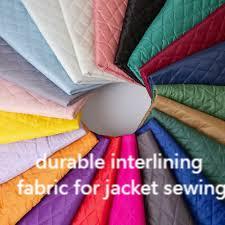Interlining is an essential component in garment manufacturing that adds structure, support, and durability to clothing. It is placed between the outer fabric and the lining, enhancing the garment's overall shape and fit. Interlining can be found in a variety of forms and is selected based on the fabric, garment type, and the desired end result. From suits to dresses, interlining plays a crucial role in ensuring that garments hold their shape while remaining comfortable and wearable.
1. The Role of Support in Garment Design
Support is a fundamental element in the design of any garment, whether it’s a tailored jacket or a soft blouse. The right balance of structure helps garments maintain their shape and ensures they fit properly. In structured garments like blazers, interlining provides the necessary stiffness to achieve a sharp, tailored look, while in more relaxed styles, it allows for natural movement and comfort. Selecting the appropriate support material is essential to achieve the intended design and aesthetic.
2. Material Selection for Garments
Choosing the right materials for each part of a garment is critical to its overall performance. Fabrics like cotton, silk, and wool require different treatments to maintain their shape and appearance. The use of a material that provides internal support ensures that garments will hold up well over time, even after multiple wears and washes. In contrast, lightweight fabrics require less support, allowing them to retain a softer, more flexible shape.
3. Enhancing Garment Durability
Durability is one of the primary considerations when manufacturing high-quality garments. The use of supportive materials in areas that experience frequent stress—such as collars, cuffs, waistbands, and hems—helps maintain the garment’s structure and appearance. Durability ensures that garments remain in good condition throughout their lifecycle, making them suitable for long-term wear. When combined with the right external fabrics, durable internal support materials ensure that a garment is both functional and stylish.
4. Comfort and Flexibility in Clothing Design
While structure and durability are important, comfort should never be overlooked in garment design. Garments must not only look good but also feel good on the wearer. The right balance between structure and flexibility allows for ease of movement while ensuring that the garment maintains its shape. Comfort is particularly important for everyday wear, such as shirts, dresses, and casual wear, where the wearer needs to move freely without feeling restricted.
5. Conclusion and Contact Information
In garment manufacturing, the right combination of structure, support, and flexibility is key to producing high-quality, durable clothing. By selecting the appropriate materials and construction techniques, designers and manufacturers can ensure that their garments not only look good but also stand the test of time. For more information on the best materials and solutions for garment production, visit https://www.interlining-factory.com/product/.



